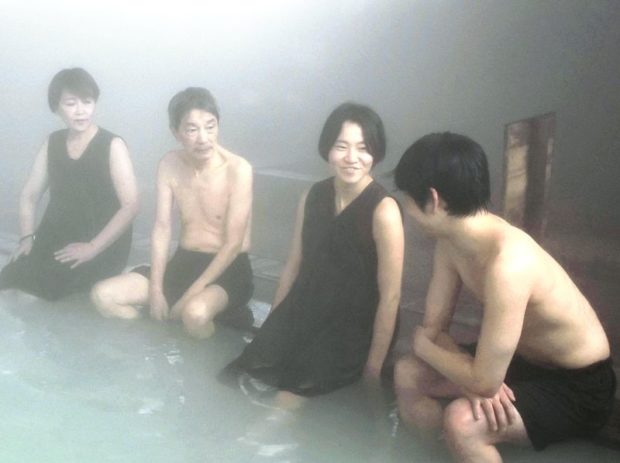Onsen industry strives to preserve mixed-gender bathing

Men and women enjoy a mixed-gender bath at a hot-spring resort in Aomori. The Yomiuri Shimbun via The Japan News/Asia News Network
TOKYO — Onsen and hot spring resorts with konyoku mixed-gender bathing facilities have been feeling the pinch of late, as customers become increasingly reticent about stripping off to take a dip with strangers. To counter this trend, many such establishments have started requesting that patrons partially cover up when taking to the water, in hopes it will help persuade people back to mixed communal pools.
A decline in customer manners is among the reasons cited for konyoku’s fall from favor.
“By encouraging the use of bathing garments, we’re hoping people’s concerns will be eased so they can again enjoy konyoku culture, irrespective of generation or gender,” an industry official said.
At Sukayu Onsen resort in Aomori — located in an area with the heaviest snowfall in the country — men and women of all ages soaked happily in the konyoku onsen at “Hiba Sennin Buro” (1,000-person bath) in late January.
Men wore knee-length pants, while women sported similar lower-half coverings and sleeveless tops. “Put simply, I don’t have to worry about being ogled,” said a woman in her 20s from Chiba Prefecture. “I can just kick back and enjoy the onsen.”
Article continues after this advertisementSukayu Onsen presently has women-only bathing times in the mornings and evenings. However, with an eye on creating a mixed-gender bathing space that can be enjoyed by everyone, the facility recently began asking patrons to wear bathing garments to see if it would attract more visitors, regardless of the session times. If customers react positively to the experiment, the facility may consider adopting the idea permanently.
Article continues after this advertisementIn 2019, Jigoku Onsen Seifusou in Minami-Aso, Kumamoto Prefecture, began stipulating that guests wear bathing costumes when using the onsen. “We adopted the rule so young people and those reluctant to take konyoku can enjoy our baths,” said Seifusou’s vice president, Kenji Kawatsu.
According to onsen expert Kyoko Kitade, there were konyoku onsen at about 1,200 locations across the country in 1993, but only about 500 by 2021. “Some young people simply don’t like naked konyoku,” said Kitade, who regularly enthuses about the charms of onsen in lectures and writings. “There have been cases of poor manners, such as men staring at women’s bodies. This has caused some patrons to shy away from konyoku.”
Some onsen facilities, however, still put priority on shared, naked bathing. “There’s nothing elegant about people covering up in an onsen,” said one customer.
Yubara Onsen Sunayu in Maniwa, Okayama Prefecture, has been urging male clients to cover up since 2016. The facility placed signboards in changing rooms and other areas stating, “Let’s cover up our lower half,” in hopes of encouraging guests to wear a towel or swimsuit. Nonetheless, some patrons ignore this request and continue to enter the water au naturel. “I want to be naked when I bathe in an onsen,” said one such individual.
Onsen expert Aya Uchida, an associate professor at Toyo University, said, “It’s important for each region and facility to think about how to pass down konyoku culture.”
Meanwhile, Michio Ishikawa, president of the Regional Science Association of Spa, Japan, said, “The use of bathing garments is one way for hot-spring resorts to respond to present-day needs and aims, such as a genderless society.”
RELATED STORIES